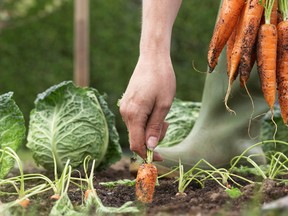Think vertical when space is tight
Reviews and recommendations are unbiased and products are independently selected. Postmedia may earn an affiliate commission from purchases made through links on this page.
Article content
Q. We are still in the process, as a family, of putting together our first vegetable garden. As with most gardens these days, our space is limited and we realize we must make choices. How do you decide on what vegetables, and how much of each, to plant?
Advertisement 2
Article content
A. First, make a list of the family’s favourite vegetables. Then, since this is your first venture into food gardening, choose among them the easiest to grow, such as lettuce, green beans, carrots, cucumbers, kale, Swiss chard, zucchini, and beets. Lettuce, cucumber, kale, chard and zucchini transplants are usually available.
Article content
To save space, grow as many plants as possible vertically, on netting or against movable wire fencing. Vining peas, pole and runner beans, cucumbers and staking tomatoes take little space grown vertically. Small salad vegetables can be grown close to and alongside the climbing vegetables, taking up almost no space.
Instead of seeding in individual rows, I grow all but the largest plants in closely spaced blocks. This works well as long as the soil is fertile and well plumped with compost. This way, I can grow surprisingly hefty numbers of carrots and beets in a small space, and a year’s supply of garlic.
Advertisement 3
Article content
I locate winter squash plants on partly finished compost heaps and along plot edges to trail onto adjacent pathways.
I grow the most of what I like the best. I aim for close to a year’s supply of peas, to enjoy them “minted” after I’ve steam-blanched them for the freezer with fresh mint in the boiling water beneath the peas. I grow enough tomatoes for soup and sauces through the winter, and enough zucchini for cooking with onion and garlic and pureeing for winter soups.
I grow close to a year’s supply of carrots to be sure of having sweet, juicy, fine-textured carrots through the winter. For a similar reason I try to produce enough onions for a supply of high quality bulbs.
Recommended from Editorial
-

‘Conservation corridors’ of wildlife habitat help address needs of local ecosystem
-

Be careful when watering transplanted lemon cypress
Article content


Comments
Postmedia is committed to maintaining a lively but civil forum for discussion and encourage all readers to share their views on our articles. Comments may take up to an hour for moderation before appearing on the site. We ask you to keep your comments relevant and respectful. We have enabled email notifications—you will now receive an email if you receive a reply to your comment, there is an update to a comment thread you follow or if a user you follow comments. Visit our Community Guidelines for more information and details on how to adjust your email settings.